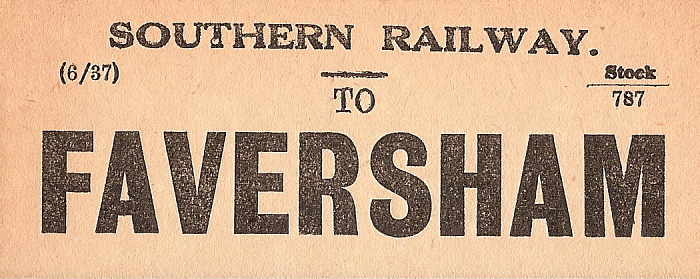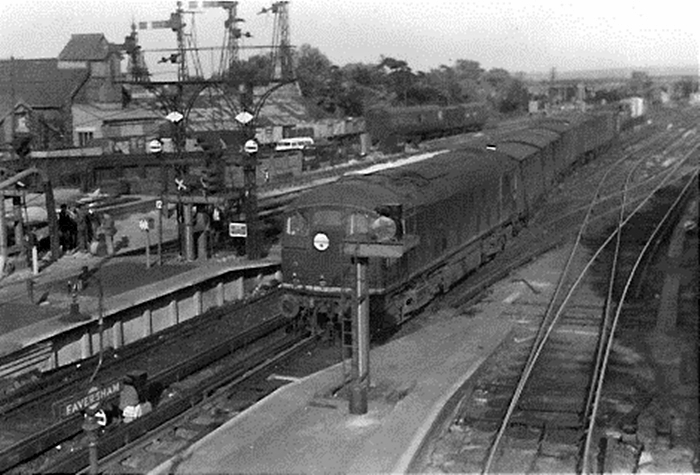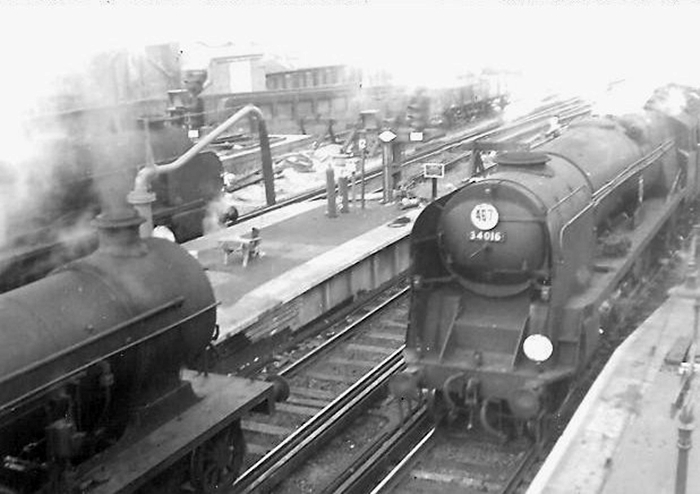
Faversham
It would be no exaggeration to suggest that Faversham’s capacity to handle goods traffic, as a result of the rebuild, exploded. The station site fully realised its importance of being positioned at the divergence of two Kent Coast routes, and the 1897/1898 reconstruction took the opportunity to incorporate a multitude of sidings to the east of the platforms and around the junction. The creek branch continued to veer off sharply to the north of the layout, but now it could be directly accessed from the running lines without the need for a reversing manoeuvre. A considerable amount of open space existed around the departing branch, immediately north of the Whitstable line. This land subsequently became host to a spacious goods yard consisting of no less than twelve lengthy sidings – three of these were roughly westward-facing, whilst the remaining nine were southward-facing. The yard also incorporated a brick-built single-track goods shed. This was a through affair, and the main section of the structure measured 110-feet in length. Motive power facilities also witnessed a decided improvement: the engine shed was doubled in size, a wagon repair shop came into use, and a replacement turntable – of 50-foot diameter – came into use. The engine shed is looked at in more detail in the Faversham (73E) section. This was a strategic location, where trains would either be split or amalgamated; thus, provision was made for rolling stock storage. A trio of westward-facing carriage sidings were installed immediately south of the departing Dover line. It is worth noting at this point that whilst the ‘’down’’ side main building was separated from the ‘’down’’ island by a single line, between the ‘’up’’ main building and ‘’up’’ island existed a double-track. One of these tracks was, naturally, the platform line, but the other was a rolling stock siding arranged in the form of a loop. The ‘’down’’ side was not without sidings (in addition to the aforementioned tracks which terminated alongside the creek branch), and five eastward-facing tracks presented themselves just to the east of the ‘’up’’ island. However, these formed an extension of the goods yard, rather than being designated for passenger rolling stock storage. Finally, suspended above the diverging Kent Coast routes, the Creek branch, and the goods sidings, was a 570-foot long public footbridge. This was of the same lattice construction as the example which straddled the station’s platforms.
The rebuilt layout was signalled by Saxby & Farmer, the same contractor of which provided the equipment for the previous Faversham station. The complexity of the track arrangement here required the building of three signal cabins:
Signal Box ‘’A’’: This was at the London end of the layout, positioned on the ‘’down’’ side, about 90 yards west of the platforms. The cabin was an all-brick two-storey-high structure, built to the same design as the Saxby & Farmer signal box still in existence at Gillingham.
Signal Box ‘’B’’: This signal cabin was built to the same all-brick Saxby & Farmer design as ‘’A’’ box, but was about twice the length of it. The cabin necessitated a much larger frame to control the complex junction layout. The cabin was positioned about 110 yards east of the ‘’up’’ platform, immediately south of the rolling stock sidings.
Goods Yard Signal Box: The goods yard was large enough to command its own dedicated signal cabin. This was a diminutive single-storey all-timber structure with a pitched roof. It was positioned immediately north of the goods yard approach tracks.
Under Southern
Railway ownership, Faversham changed little. The station already demonstrated a
modern arrangement as a result of the comparatively recent rebuild, and the SR
was preoccupied with rationalising the lines of Thanet. Naturally, the SR
installed its trademark ‘’Target’’ platform name plates, and replaced the
existing diamond-shaped gas lamp heads with swan neck-shaped types, but the
greatest of alterations were to come with the Southern Region’s Kent Coast
Electrification Scheme. ‘’Phase 1’’ of this included ex-LC&DR lines (except
Maidstone East to Ashford, which became part of ‘’Phase 2’’), and involved the
installation of third rail alongside 178 miles of track. Components for this
undertaking started being delivered to sites throughout 1958, and it was also in
this year that construction of a replacement ‘’power box’’ at Faversham began.
This was positioned immediately to the west of the existing Saxby & Farmer ‘’B’’
signal box, and was of the typical two-storey brown brick and glazed design,
with a flat roof. Three-aspect colour lighting was installed at the layout,
which included the use of three-aspect ‘’lunar’’ junction indicators. The goods
yard was installed with overhead catenary for use by the E5000 Series Type HA
(later Class 71) electric locomotives. Introduced during 1959, this type could
take power from either third rail or a simple overhead wire system. With
reference to the latter, this had been developed for a number of South Eastern
Division yards and sidings where exposed third rail would have been potentially
dangerous for staff. The three ‘’up’’ side carriage berthing sidings to the east
of the platforms were electrified for EMU use, and electric lighting – supported
by concrete posts – was installed alongside these tracks. Prefabricated concrete
walkways had also been installed beside these sidings in 1958. The engine shed
site received fuel tanks in preparation for the conversion from a steam shed to
a diesel depot.
The ‘’power box’’ and colour lights were brought into use on 24th May 1959,
superseding the mechanical cabins and semaphore signals. The goods yard retained
its diminutive single-storey wooden cabin, and the sidings there continued to be
worked by mechanical levers. Practice runs in electric multiple units began on
1st June 1959, and on 9th of this month, ‘’Phase 1’’ was formally deemed
complete. The full accelerated electric timetable came into use on 15th June,
and the entire scheme thus far had cost approximately £25 million (circa £415
million at 2006 prices) to implement. Goods traffic remained at Faversham until
16th August 1971, but subsequent site clearing left the LC&DR goods shed
completely intact. The creek branch had previously closed during 1964. Rolling
stock berthing continues at Faversham, and after undergoing a refurbishment
programme in about 1985, this remains an attractive and impressive station. The
former goods yard area has recently entered into a phase of redevelopment, but
it appears that the isolated goods shed structure will continue to be a feature
of the site.

Faversham Luggage Label: ''Stock 787'' was a practice adopted from the LSWR. Raymond Fuell
1959

Unrebuilt Battle of Britain Class No. 34084 ''253 Squadron'' is seen approaching the station from the Kent
Coast line to Herne Bay and Margate. In tow is Blood & Custard BR Mk 1 stock and some green Bulleid
vehicles. On the right can be seen the then recently completed (but yet to be commissioned) ''power box'',
whilst behind it is the Saxby & Farmer predecessor. In the background can be seen the still operational
engine shed, behind which is the huge lattice footbridge. The Late Brian Relf, © Colin Relf
14th May 1959

No. D5007 is seen trundling into the station on the ''up'' main from the goods yard, hauling a rake of ventilated
vans. The splendid semaphore signals were soon to be replaced by colour lights, which were already in place.
Seven of these diesels arrived on the South Eastern Division in January 1959, where they could temporarily
provide steam heating for coaching stock prior to complete electrification. The native D6500 (Class 33) diesels
of the SR were equipped with electric train heating (ETH) only. The Late Brian Relf © Colin Relf
29th May 1959

The colour light signals had been operational for five days by the time of this view, but steam was still hanging
on - just. A trio of locomotives include Rebuilt West Country Class No. 34016 ''Bodmin'', trundling in from
Ramsgate with a Victoria service. In the middle is a Class L1 4-4-0, a long serving type on the ''Chatham''
main line, and on the far left, a ''Schools'' 4-4-0. The Late Brian Relf © Colin Relf
Pages: 1 2 3 4 5 6 7 8 Accidents
Return to the Kent Rail Homepage or alternatively, check for Updates.
Website & Copyright information - Links - Contact the Webmaster
All content is copyright © David Glasspool unless otherwise stated